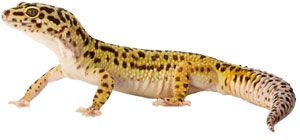Overview
Habitat
Making A Home
Care
Habitat

Terrarium: Use a well ventilated 10 Gallon terrarium or larger for a pair. Use a larger terrarium for multiple pets.
Heating & Humidity:
-Equip the habitat with two thermometers: one on the ‘warm side’ and one on the ‘cool side’ of the terrarium and one hygrometer to monitor humidity.
– Provide heat with an under-tank heater. Turn the heater off for 12 hours at night, as long as the ambient room temperature does not drop below 18 degrees Celsius.
-Place a daytime heat ulb over the habitat to provide warmth. Turn the heat bulb off for 12 hours at night.
-Create and maintain humidity by keeping the water dish full, misting your pet and habitat every other day or by using an automatic fogger, mister, or drip system, if desired.
Lighting:
-Every reptile requires a 12-hour light/ dark cycle.
-Leopard geckos are nocturnal and spend most daytime hours hidden. Provide a fluorescent bulb, if ambient light is insufficient.
-If desired, use a night -specific bulb to view your pet at night without disturbing their natural behaviour.
Temperature:
Day- cool side: 75-85 degrees F (24-29 degrees C)
Day- warm side: 85-95 degrees F (29-35 degrees C)
Night: 65-75 degrees F (18-24 degrees C)
Making A Home
Decor: Use 2-3″ of calcium sand or use reptile carpet for leopard geckos under 6″ to avoid sand digestion.Spot clean at least once a week, and completely change substrate at least once a month.
Add a wood or rock hiding place on the cool side of the terrarium, at least one per gecko. Line the hiding spot with humidity-retaining moss to provide necessary moisture. Providing live or artificial plants and branches for hiding and climbing is also required. As always, provide a water dish and you’ll also want to ensure that the decor is large enough to support your pet and is stable.

Care
Leopard geckos are insectivores. Their primary food source is crickets, however variety is always important for a balanced diet so you can alternate the variety of insects offered. Douse insects with calcium powder supplement twice weekly and a reptile multivitamin once weekly. Feed them at nighttime, and offer only as many crickets as your gecko can eat in 10-15 minutes. You can also feed them fruits and vegetables like papaya, strawberries, dark greens and carrots- these should only make up 20% of their diet.
